Advances in the Rheology of Synthetic Binder for Sustainable Road Pavements: An Improved Protocol for DSR Testing
Abstract
1. Introduction
2. Objective and Research Approach
- plain rheological behavior of binders (time–temperature superposition concerns for bituminous and synthetic binders);
- preliminary conditions for complex rheological behavior (analysis of steric hardening, time–temperature dependency and the linear visco-elastic (LVE) region, localizing the assumptions of linearity/thermorheological simplicity);
- complex rheological behavior of binders (to furnish a comprehensive report concerning their expected mechanical responses).
3. Materials
4. Testing Methods
4.1. Plain Rheological Behavior of Binders
4.2. Preliminary Conditions for the Complex Rheological Behavior
4.3. Complex Rheological Behavior of Binders
5. Results, Analysis and Discussions
5.1. Plain Rheological Behavior of Binders
- the loss of linearity should be averted thanks to the low strain constantly applied during the DSR test (0.5%);
- the torque limits related to equipment compliance were never exceeded during the tests;
- a good repeatability between the three test replicates was obtained for SB.
5.2. Preliminary Conditions for the Complex Rheological Behavior
5.3. Complex Rheological Behavior of Binders
- for anl(T,) (horizontal scale factor), the temperature T had a linear effect on shifting, similar to that widely experienced in conventional T-scaling through the relation of the log(aT) = C · (T − T0) [32], whereas the strain rate contribution could be modeled through a power law relation;
- for bnl(T,) (vertical scale factor), the temperature was not an influence; thus, a power-type fitting law related to the strain rate was only enough to model the vertical scaling.
6. Conclusions and Prospects for Further Studies
- the synthetic binder presented an initial relaxation phenomenon that suggested the adoption of a conditioning time equal to 15 min; no specific steric hardening was experienced with the long testing period;
- the visco-elastic behavior of the synthetic binder was very different compared to a reference plain road bitumen;
- it was possible to implement an advanced DSR protocol imposing constant strain rates in oscillatory mode in order to enter the non-linear visco-elastic region to collect info about the large stress–strain fields, typically linked to pavement rutting or cracking phenomena;
- feasible master curves of the non-linear rheological data were constructed; this was made through horizontal and vertical scaling factors (function of the temperature and the strain rate) based on linear and power law equations;
- such master curves resulted in additional advice about the rheological response of the synthetic resin with complex behavior, above all with respect to phase angle.
Author Contributions
Funding
Institutional Review Board Statement
Informed Consent Statement
Data Availability Statement
Conflicts of Interest
References
- Liu, Q.; Wu, J.; Qu, X.; Wang, C.; Oeser, M. Investigation of bitumen rheological properties measured at different rheometer gap sizes. Constr. Build. Mater. 2020, 265, 120287. [Google Scholar] [CrossRef]
- Jing, R.; Varveri, A.; Liu, X.; Scarpas, A.; Erkens, S. Laboratory and field aging effect on bitumen chemistry and rheology in porous asphalt mixture. Transp. Res. Rec. 2019, 2673, 365–374. [Google Scholar] [CrossRef]
- Jing, R.; Varveri, A.; Liu, X.; Scarpas, A.; Erkens, S. Rheological, fatigue and relaxation properties of aged bitumen. Int. J. Pavement Eng. 2019, 21, 1024–1033. [Google Scholar] [CrossRef]
- Ishaq, M.A.; Giustozzi, F. Correlation between rheological tests on bitumen and asphalt low temperature cracking tests. Constr. Build. Mater. 2022, 320, 126109. [Google Scholar] [CrossRef]
- Bueno, M.; García, A.; Partl, M.N. Application of strain-rate frequency superposition for bituminous binders. Appl. Rheol. 2015, 25, 65980. [Google Scholar]
- Zhang, Z.; Fang, Y.; Yang, J.; Li, X. A comprehensive review of bio-oil, bio-binder and bio-asphalt materials: Their source, composition, preparation and performance. J. Traffic Transp. Eng. 2022, 9, 151–166. [Google Scholar] [CrossRef]
- Porto, M.; Caputo, P.; Loise, V.; Abe, A.A.; Tarsi, G.; Sangiorgi, C.; Gallo, F.; Rossi, C.O. Preliminary study on new alternative binders through re-refined engine oil bottoms (REOBs) and industrial by-product additives. Molecules 2021, 26, 7269. [Google Scholar] [CrossRef]
- Zhang, H.; Chen, Z.; Zhu, C.; Wei, C. An innovative and smart road construction material: Thermochromic asphalt binder. In New Materials in Civil Engineering; Samui, P., Kim, D., Iyer, N.R., Chaudhary, S., Eds.; Butterworth-Heinemann: Oxford, UK, 2020; pp. 691–716. [Google Scholar]
- Zhang, Z.; Huang, Z.; Zhou, W.; Xu, R.; Xu, J.; Liu, Y. Study on synthesis and road performance of light-colored resin modified asphalt. IOP Conf. Ser. Earth Environ. Sci. 2021, 770, 012003. [Google Scholar] [CrossRef]
- Iwański, M.; Mazurek, G. Rheological characteristics of synthetic wax-modified asphalt binders. J. Chem. Technol. Polymer Proc. 2012, 57, 661–664. [Google Scholar] [CrossRef]
- Mullins, O.C.; Sheu, E.Y.; Hammami, A.; Marshall, A.G. Asphaltenes, Heavy Oils, and Petroleomics; Springer: Berlin, Germany, 2007. [Google Scholar]
- Tang, P.; Mo, L.; Pan, C.; Fang, H.; Javilla, B.; Riara, M. Investigation of rheological properties of light colored synthetic asphalt binders containing different polymer modifiers. Constr. Build. Mater. 2018, 161, 175–185. [Google Scholar] [CrossRef]
- Merusi, F.; Giuliani, F. Chromatic and rheological characteristics of clear road binders. Transp. Res. Rec. 2012, 2293, 114–122. [Google Scholar] [CrossRef]
- Di Maria, V.; Rahman, M.; Collins, F.; Dondi, G.; Sangiorgi, C. Urban heat island effect: Thermal response from different types of exposed paved surfaces. Int. J. Pavement Res. Technol. 2013, 6, 414–422. [Google Scholar]
- Pasetto, M.; Pasquini, E.; Giacomello, G.; Baliello, A. Innovative pavement surfaces as urban heat islands mitigation strategy: Chromatic, thermal and mechanical characterisation of clear/coloured mixtures. Road Mat. Pav. Des. 2019, 20 (Suppl. 1), S533–S555. [Google Scholar] [CrossRef]
- Navarro, F.J.; Partal, P.; Martínez-Boza, F.; Gallegos, C. Effect of composition and processing on the linear viscoelasticity of synthetic binders. Eur. Polym. J. 2005, 41, 1429–1438. [Google Scholar] [CrossRef]
- Mansourkhaki, A.; Ameri, M.; Habibpour, M.; Underwood, B.S. Relations between colloidal indices and low-temperature properties of reclaimed binder modified with softer binder, oil-rejuvenator and polybutadiene rubber. Constr. Build. Mater. 2020, 239, 117800. [Google Scholar] [CrossRef]
- Airey, G.D.; Rahimzadeh, B. Combined bituminous and mixture linear rheological properties. Constr. Build. Mater. 2004, 18, 535–548. [Google Scholar] [CrossRef]
- Airey, G.D.; Mohammed, M.H.; Fichter, C. Rheological characteristics of synthetic road binders. Fuel 2008, 87, 1763–1775. [Google Scholar] [CrossRef]
- Kriz, P.; Stastna, J.; Zanzotto, L. Temperature dependence and thermo-reversibility of physical hardening of asphalt binders. In Proceedings of the 4th Eurasphalt and Eurobitume Congress, Copenhagen, Denmark, 21–23 May 2008. [Google Scholar]
- Divya, P.S.; Krishnan, J.M. How to consistently collect rheological data for bitumen in a dynamic shear rheometer? SN Appl. Sci. 2018, 1, 100. [Google Scholar] [CrossRef]
- Grilli, A.; Bocci, M.; Virgili, A.; Conti, C. Mechanical characterization and chemical identification of clear binders for road surface courses. Cold Tech. Mater. Sustain. Pavement Constr. Rehabil. 2020, 2020, 4930646. [Google Scholar] [CrossRef]
- Pasetto, M.; Baliello, A.; Giacomello, G.; Pasquini, E. Aesthetic and mechanical suitability of a clear synthetic resin as a unconventional binder for road pavements. Adv. Mater. Sci. Eng. 2019, 2019, 8643608. [Google Scholar] [CrossRef]
- Sybilski, D.; Soenen, H.; Gajewski, M.; Chailleux, E.; Bankowski, W. Binder testing. In Advances in Interlaboratory Testing and Evaluation of Bituminous Materials; RILEM State-of-the-Art Report 9; Springer: Berlin, Germany, 2013. [Google Scholar]
- Johnson, C.M.; Bahia, H.U.; Wen, H. Evaluation of strain-controlled asphalt binder fatigue testing in the dynamic shear rheometer. In Proceedings of the 4th International SIIV Congress, Palermo, Italy, 12–14 September 2007. [Google Scholar]
- Williams, M.L.; Landel, R.F.; Ferry, J.D. The temperature dependence of relaxation mechanisms in amorphous polymers and other glass-forming liquids. J. Am. Chem. Soc. 1955, 77, 3701–3707. [Google Scholar] [CrossRef]
- Bahia, H.U.; Hanson, D.I.; Zeng, M.; Zhai, H.; Khatri, M.A.; Anderson, R.M. Characterization of modified asphalt binders in Superpave mix design. In NCHRP Report 459; National Cooperative Highway Research Program: Washington, DC, USA, 2011. [Google Scholar]
- Airey, G.; Sias, J.E.; Rowe, G.M.; Di Benedetto, H.; Sauzét, C.; Dave, E.V. An overview of Black space evaluation of performance and distress mechanisms in asphalt materials. In Proceedings of the RILEM International Symposium on Bituminous Materials, Lyon, France, 14–16 December 2020. [Google Scholar]
- Little, D.N.; Allen, D.H.; Bashin, A. Modeling and Design of Flexible Pavements and Materials; Springer: Berlin, Germany, 2018. [Google Scholar]
- Malkin, A.Y. Non-linearity in rheology—An essay of classification. Rehol. Acta 1995, 34, 27–39. [Google Scholar] [CrossRef]
- Wyss, H.M.; Miyazaki, K.; Mattsson, J.; Hu, Z.; Reichman, D.R.; Weitz, D.A. Strain-rate frequency superposition: A rheological probe of structural relaxation in soft materials. Phys. Rev. Lett. 2007, 98, 238303. [Google Scholar] [CrossRef] [PubMed]
- Fan, B.; Kazmer, D.O. Low-temperature modeling of the time-temperature shift factor for polycarbonate. Adv. Polym. Technol. 2005, 24, 278–287. [Google Scholar] [CrossRef]
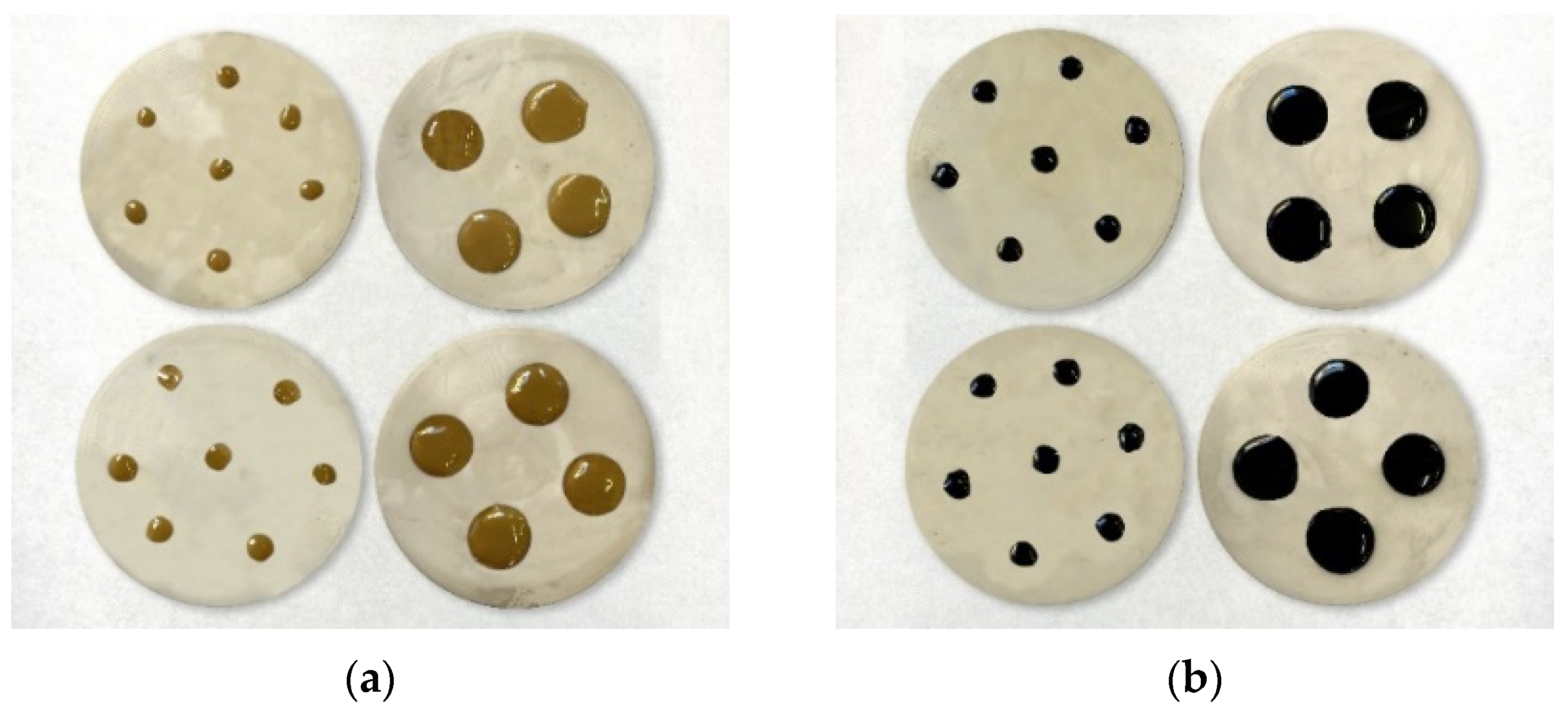
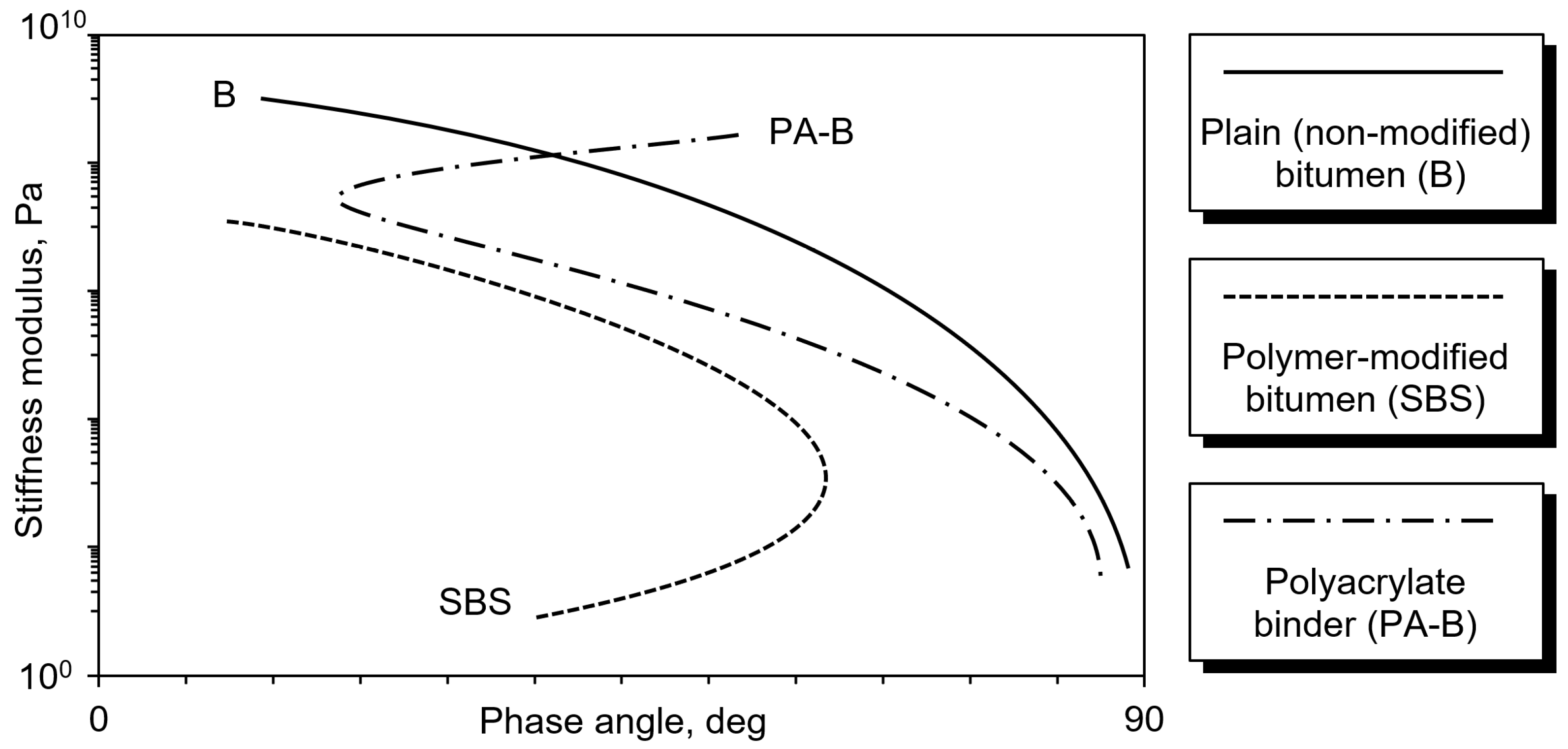
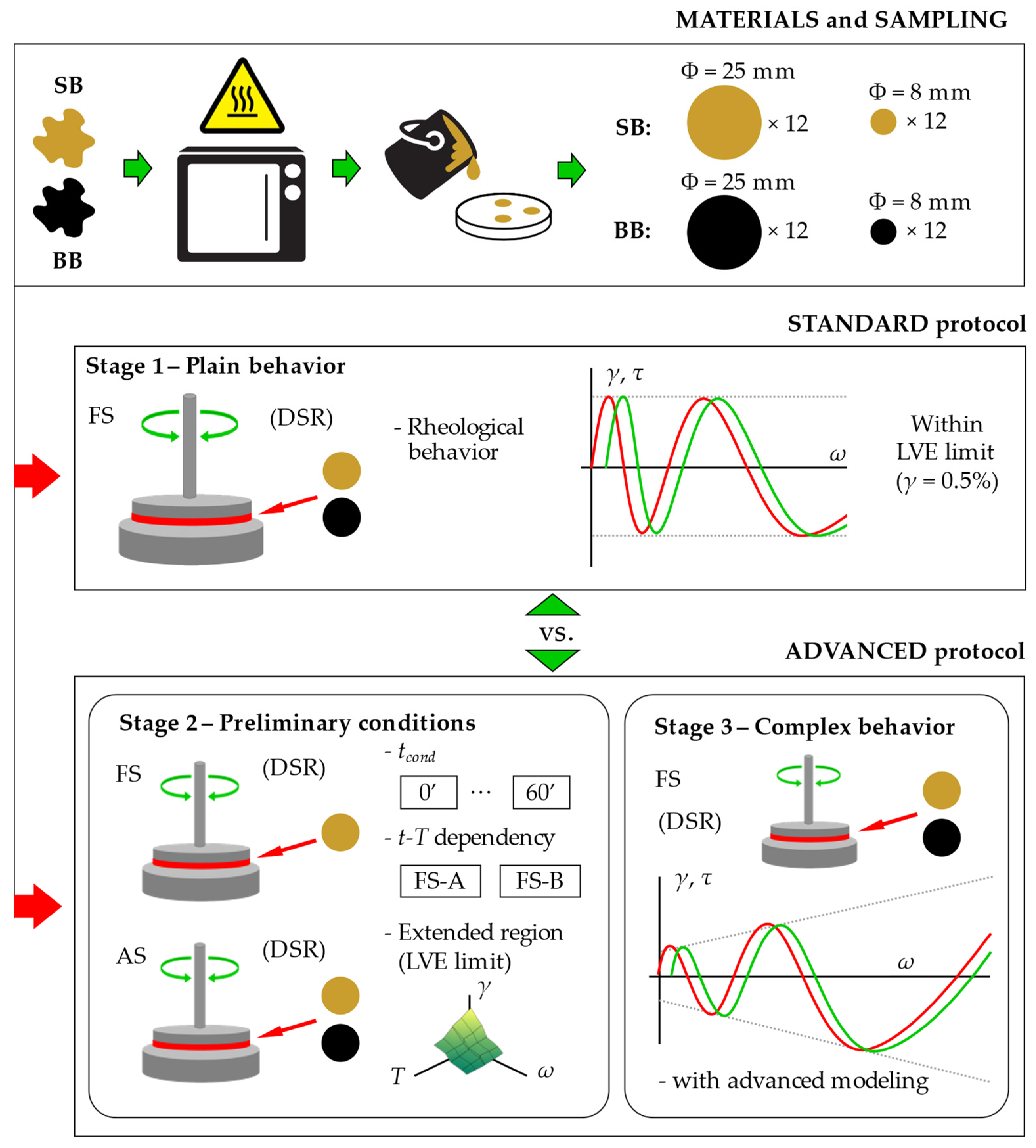
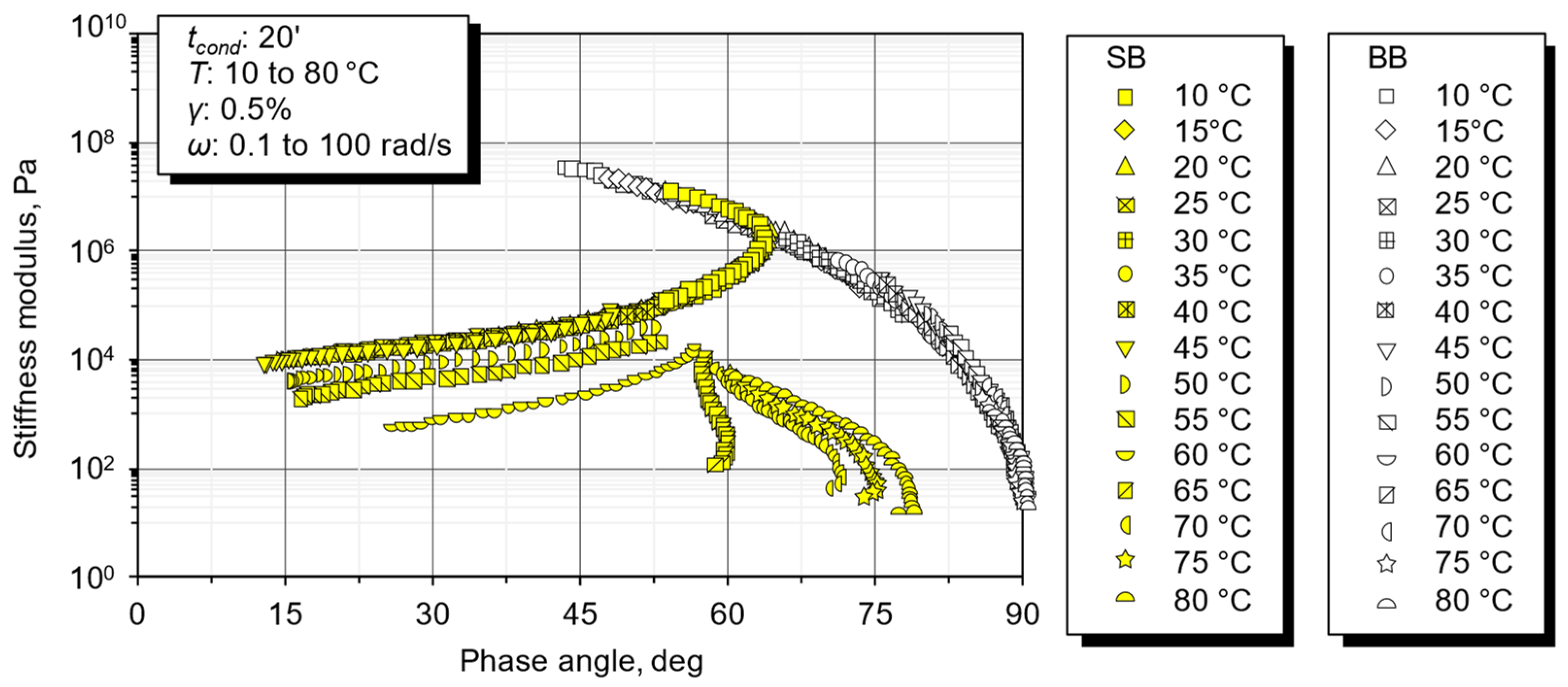
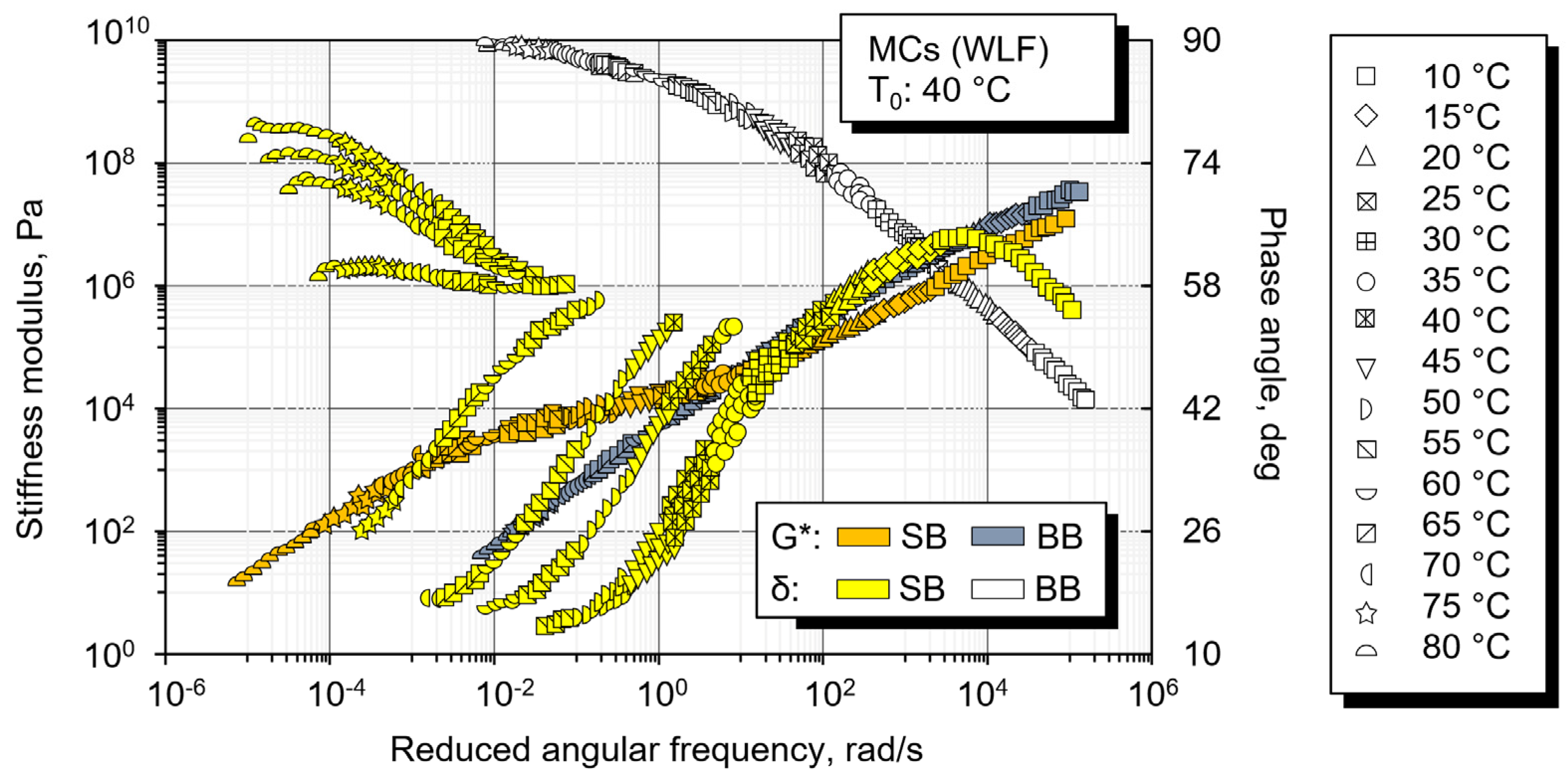
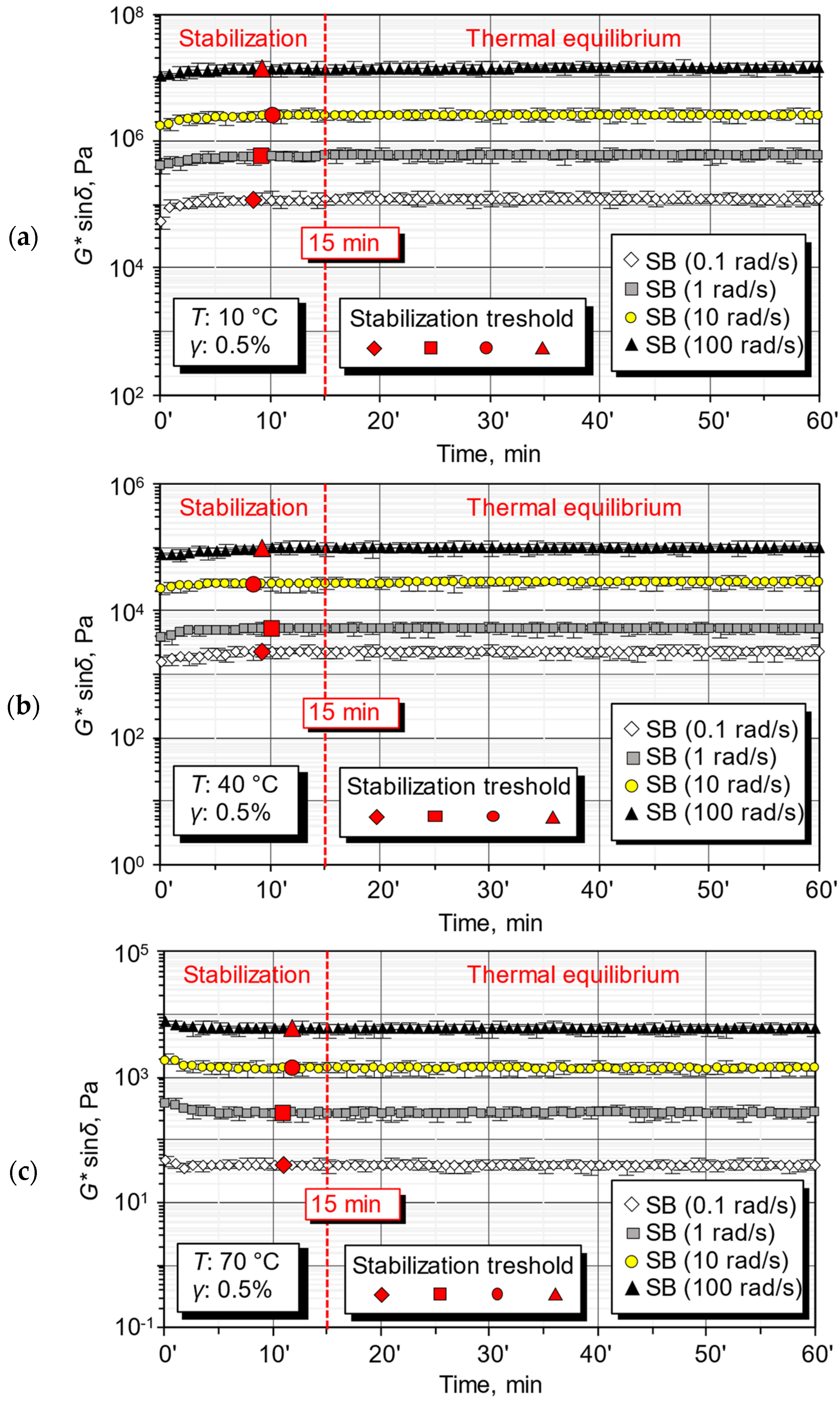

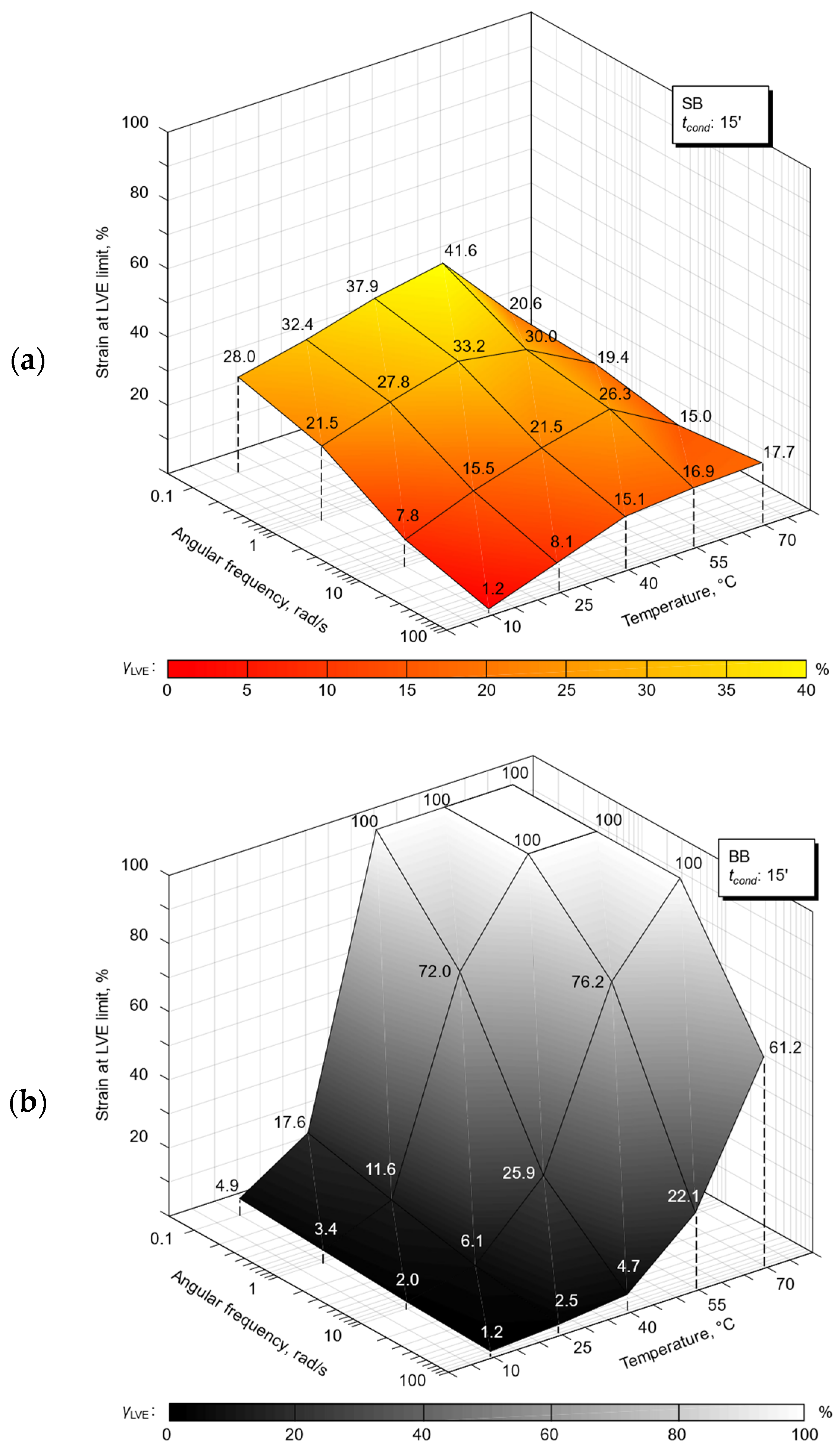
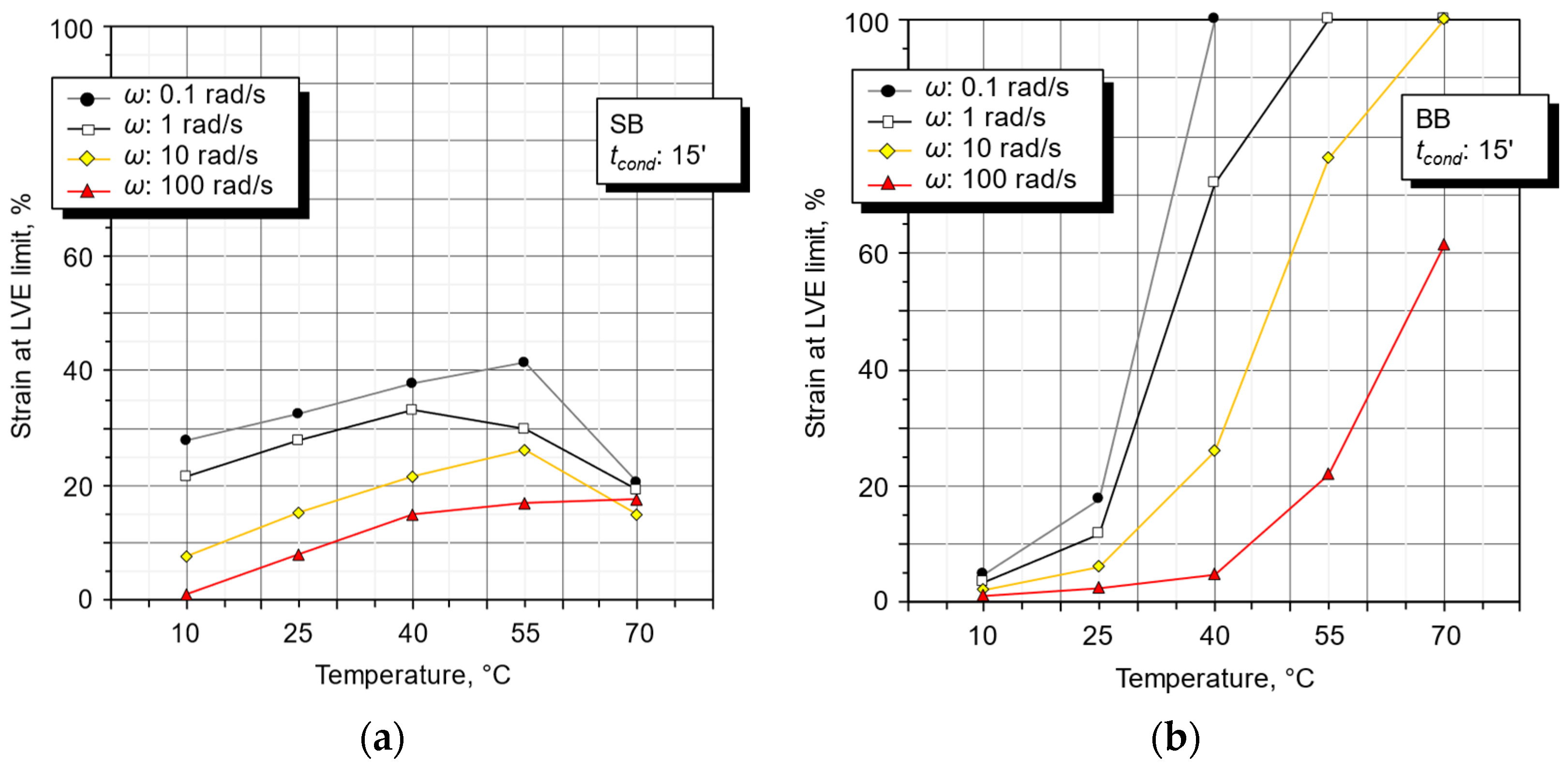
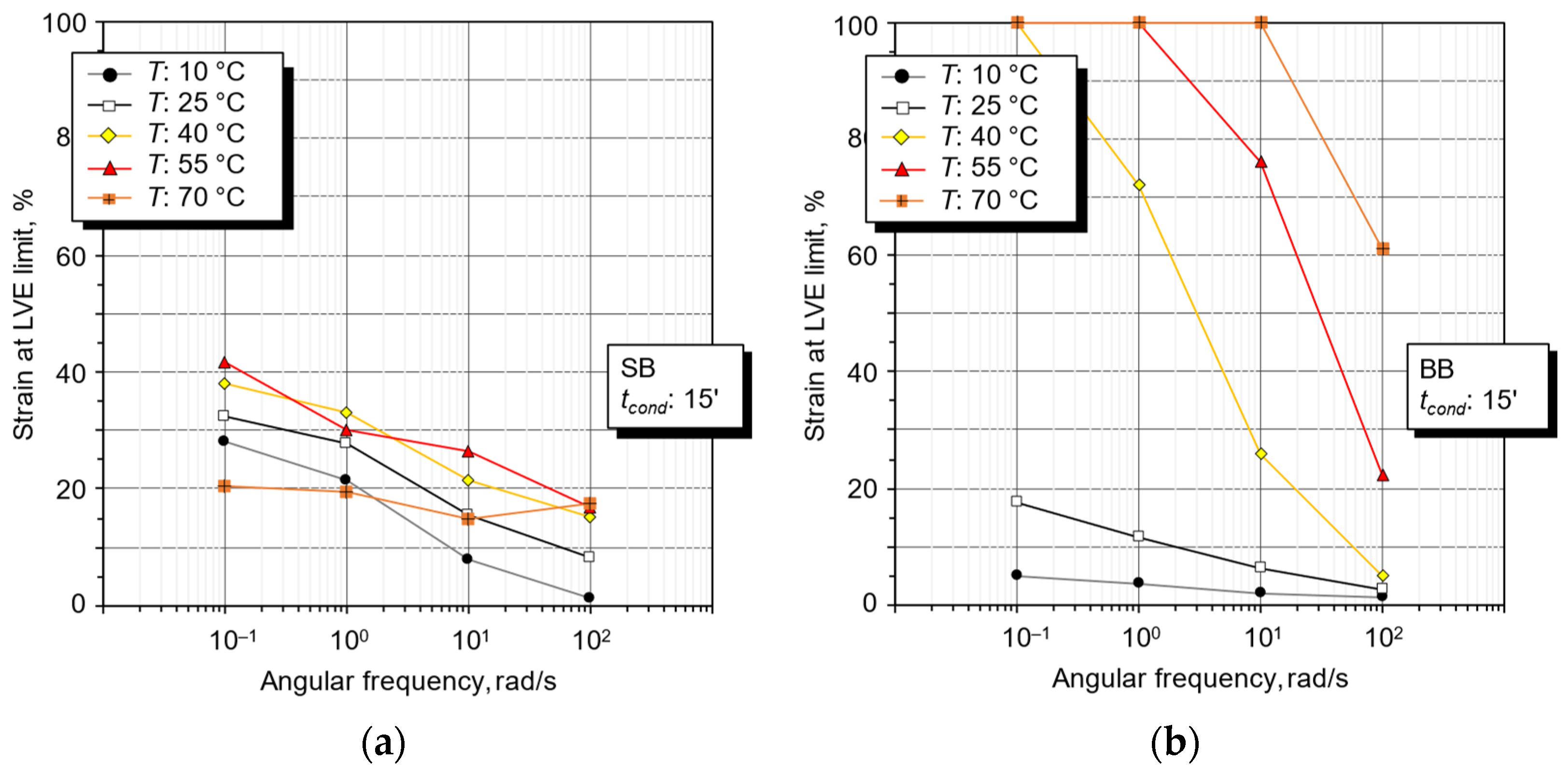

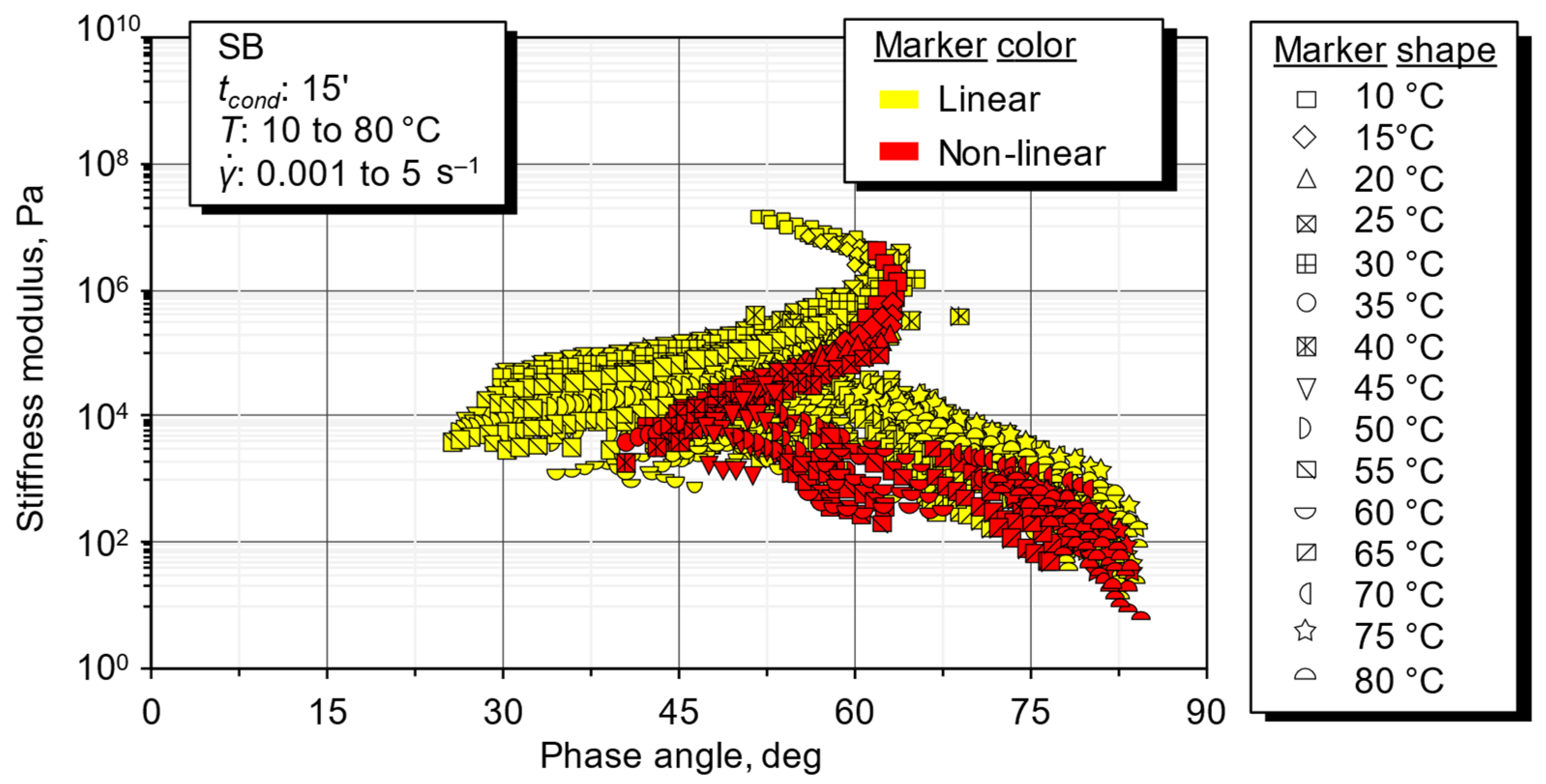
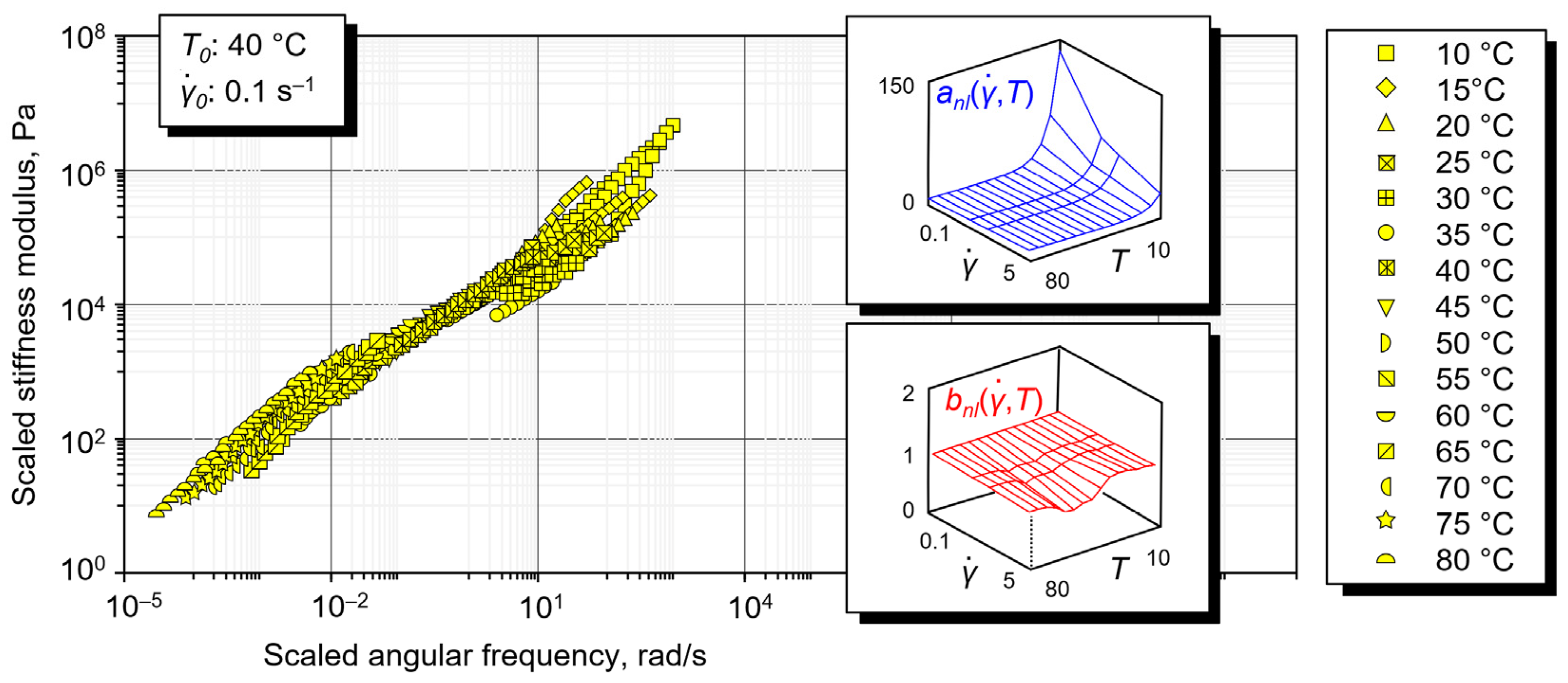
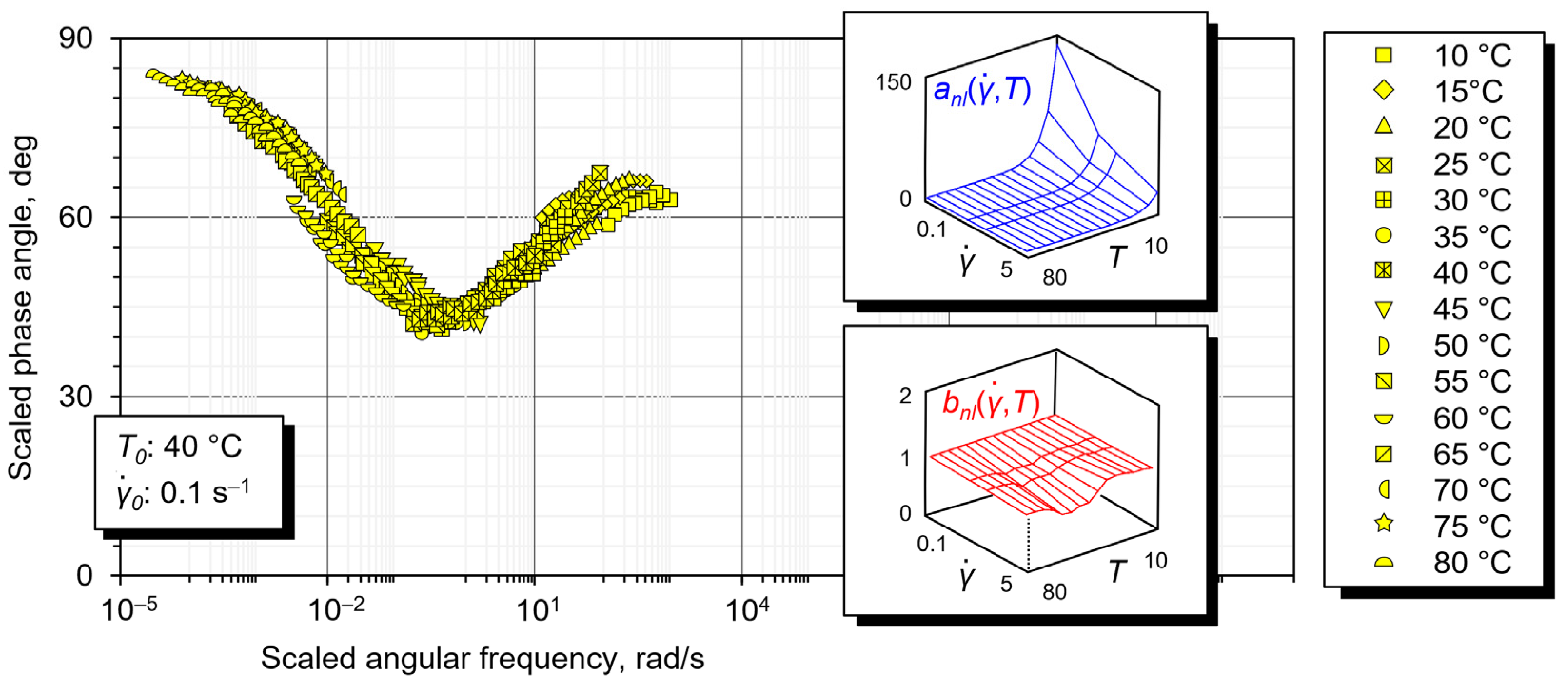
| Property | SB | BB | Standard |
|---|---|---|---|
| Penetration at 25 °C | 72 dmm | 77 dmm | EN 1426 |
| Softening point | 59 °C | 43 °C | EN 1427 |
| Ductility at 25 °C | 230 mm | >1000 mm | CNR 44 |
| Fraass breaking point | −7.5 °C | −8.2 °C | EN 12593 |
| Penetration at 25 °C (after RTFO) | 55 dmm | 52 dmm | EN 12607-1 |
| Softening point (after RTFO) | 64 °C | 50 °C | EN 12607-1 |
| Test Series 1—Analysis of tcond | ||||||
| T | γ | ω | PP | N | t | |
| 10 °C | 0.5% | 0.1, 1, 10 or 100 rad/s (constant) | PP08 | 0 N (constant) | 60 min | |
| 40 °C | 0.5% | 0.1, 1, 10 or 100 rad/s (constant) | PP08 | 0 N (constant) | 60 min | |
| 70 °C | 0.5% | 0.1, 1, 10 or 100 rad/s (constant) | PP25 | 0 N (constant) | 60 min | |
| Test Series 2—Analysis of t-T Dependency | ||||||
| T | γ | ω | tcond | PP | N | Protocol |
| 10 °C | 0.5% | 0.1 to 100 rad/s | * | PP08 | 0 N (constant) | FS-A |
| 40 °C | 0.5% | 0.1 to 100 rad/s | * | PP08 | 0 N (constant) | FS-A |
| 70 °C | 0.5% | 0.1 to 100 rad/s | * | PP25 | 0 N (constant) | FS-A |
| 10 °C | 0.5% | 0.1 to 100 rad/s | * | PP08 | 0 N (constant) | FS-B |
| 40 °C | 0.5% | 0.1 to 100 rad/s | * | PP08 | 0 N (constant) | FS-B |
| 70 °C | 0.5% | 0.1 to 100 rad/s | * | PP25 | 0 N (constant) | FS-B |
| Test Series 3—Analysis of LVE Limit | ||||||
| T | γ | ω | tcond | PP | N | |
| 10 °C | 0.01 to 100% | 0.1, 1, 10 or 100 rad/s (const.) | * | PP08 | 0 N (const.) | |
| 25 °C | 0.01 to 100% | 0.1, 1, 10 or 100 rad/s (const.) | * | PP08 ** | 0 N (const.) | |
| 40 °C | 0.01 to 100% | 0.1, 1, 10 or 100 rad/s (const.) | * | PP25 ** | 0 N (const.) | |
| 55 °C | 0.01 to 100% | 0.1, 1, 10 or 100 rad/s (const.) | * | PP25 | 0 N (const.) | |
| 70 °C | 0.01 to 100% | 0.1, 1, 10 or 100 rad/s (const.) | * | PP25 | 0 N (const.) | |
| T | γ | ω | tcond | PP | N | |
|---|---|---|---|---|---|---|
| 10 to 80 °C (5 °C step) | 0.001 s−1 (const.) | 0.01 to 100% | 10 to 0.1 rad/s | * | ** | 0 N (const.) |
| 0.005 s−1 (const.) | 0.1 to 10% | 5 to 0.05 rad/s | * | ** | 0 N (const.) | |
| 0.01 s−1 (const.) | 0.01 to 10% | 100 to 0.1 rad/s | * | ** | 0 N (const.) | |
| 0.05 s−1 (const.) | 0.1 to 10% | 50 to 0.5 rad/s | * | ** | 0 N (const.) | |
| 0.1 s−1 (const.) | 0.1 to 100% | 100 to 0.1 rad/s | * | ** | 0 N (const.) | |
| 0.5 s−1 (const.) | 1 to 100% | 50 to 0.5 rad/s | * | ** | 0 N (const.) | |
| 1 s−1 (const.) | 1 to 100% | 100 to 1 rad/s | * | ** | 0 N (const.) | |
| 5 s−1 (const.) | 1 to 100% | 50 to 5 rad/s | * | ** | 0 N (const.) |
| ω | Δ|G*|, Pa | |G*|limit, Pa | Δδ, deg | δlimit, deg |
|---|---|---|---|---|
| 0.1 rad/s | 2.98 × 103 | 4.34 × 103 | 0.233 | 0.285 |
| 0.2 rad/s | 1.45 × 103 | 1.86 × 103 | 0.05 | 0.069 |
| 0.3 rad/s | 1.51 × 103 | 1.85 × 103 | 0.072 | 0.105 |
| 0.4 rad/s | 2.05 × 103 | 2.52 × 103 | 0.057 | 0.082 |
| 0.5 rad/s | 1.49 × 103 | 1.78 × 103 | 0.048 | 0.073 |
| 0.6 rad/s | 1.83 × 103 | 2.22 × 103 | 0.024 | 0.035 |
| 0.7 rad/s | 1.96 × 103 | 2.32 × 103 | 0.039 | 0.05 |
| 0.8 rad/s | 1.07 × 103 | 1.29 × 103 | 0.029 | 0.039 |
| 0.9 rad/s | 1.12 × 103 | 1.51 × 103 | 0.017 | 0.025 |
| 1 rad/s | 1.16 × 103 | 1.32 × 103 | 0.015 | 0.022 |
| 2 rad/s | 1.30 × 103 | 1.99 × 103 | 0.02 | 0.024 |
| 3 rad/s | 1.24 × 103 | 2.09 × 103 | 0.011 | 0.013 |
| 4 rad/s | 2.43 × 103 | 3.60 × 103 | 0.005 | 0.006 |
| 5 rad/s | 2.15 × 103 | 3.03 × 103 | 0.006 | 0.008 |
| 6 rad/s | 1.26 × 103 | 1.89 × 103 | 0.003 | 0.004 |
| 7 rad/s | 3.34 × 103 | 4.24 × 103 | 0.005 | 0.005 |
| 8 rad/s | 1.46 × 103 | 2.40 × 103 | 0.003 | 0.004 |
| 9 rad/s | 2.15 × 103 | 3.64 × 103 | 0.004 | 0.006 |
| 10 rad/s | 2.98 × 103 | 4.31 × 103 | 0.002 | 0.004 |
| 20 rad/s | 3.93 × 103 | 5.79 × 103 | 0.004 | 0.005 |
| 30 rad/s | 4.12 × 103 | 6.02 × 103 | 0.004 | 0.005 |
| 40 rad/s | 7.79 × 103 | 9.68 × 103 | 0.006 | 0.007 |
| 50 rad/s | 5.49 × 103 | 7.17 × 103 | 0.005 | 0.006 |
| 60 rad/s | 7.13 × 103 | 1.08 × 104 | 0.005 | 0.007 |
| 70 rad/s | 5.46 × 103 | 6.95 × 103 | 0.004 | 0.005 |
| 80 rad/s | 1.32 × 104 | 1.79 × 104 | 0.009 | 0.012 |
| 90 rad/s | 1.09 × 104 | 1.74 × 104 | 0.008 | 0.012 |
| 100 rad/s | 1.73 × 104 | 2.12 × 104 | 0.012 | 0.014 |
| Fitting Coefficient K | ||||||||
| −0.0721 | ||||||||
| Coefficients for C1(T), C2(T), C3(T) and C4(T) | ||||||||
| T, °C | h1 (×10−3) | j1 (×10−1) | h2 (×10−3) | j2 (×10−1) | h3 (×10−3) | j3 (×10−1) | h4 (×10−3) | j4 (×10−3) |
| 10–35 | 1.949 | 3.010 | 3.601 | −5.260 | −0.438 | 10.06 | 0.602 | 0.249 |
| 40–60 | −2.444 | 4.529 | −2.840 | −2.852 | −5.096 | 11.40 | 2.920 | 90.80 |
| 65–80 | 16.601 | −6.372 | 11.16 | −10.43 | 4.468 | 6.372 | 1.360 | 121.1 |
Disclaimer/Publisher’s Note: The statements, opinions and data contained in all publications are solely those of the individual author(s) and contributor(s) and not of MDPI and/or the editor(s). MDPI and/or the editor(s) disclaim responsibility for any injury to people or property resulting from any ideas, methods, instructions or products referred to in the content. |
© 2023 by the authors. Licensee MDPI, Basel, Switzerland. This article is an open access article distributed under the terms and conditions of the Creative Commons Attribution (CC BY) license (https://creativecommons.org/licenses/by/4.0/).
Share and Cite
Pasetto, M.; Baliello, A.; Giacomello, G.; Pasquini, E. Advances in the Rheology of Synthetic Binder for Sustainable Road Pavements: An Improved Protocol for DSR Testing. Sustainability 2023, 15, 5146. https://doi.org/10.3390/su15065146
Pasetto M, Baliello A, Giacomello G, Pasquini E. Advances in the Rheology of Synthetic Binder for Sustainable Road Pavements: An Improved Protocol for DSR Testing. Sustainability. 2023; 15(6):5146. https://doi.org/10.3390/su15065146
Chicago/Turabian StylePasetto, Marco, Andrea Baliello, Giovanni Giacomello, and Emiliano Pasquini. 2023. "Advances in the Rheology of Synthetic Binder for Sustainable Road Pavements: An Improved Protocol for DSR Testing" Sustainability 15, no. 6: 5146. https://doi.org/10.3390/su15065146
APA StylePasetto, M., Baliello, A., Giacomello, G., & Pasquini, E. (2023). Advances in the Rheology of Synthetic Binder for Sustainable Road Pavements: An Improved Protocol for DSR Testing. Sustainability, 15(6), 5146. https://doi.org/10.3390/su15065146









